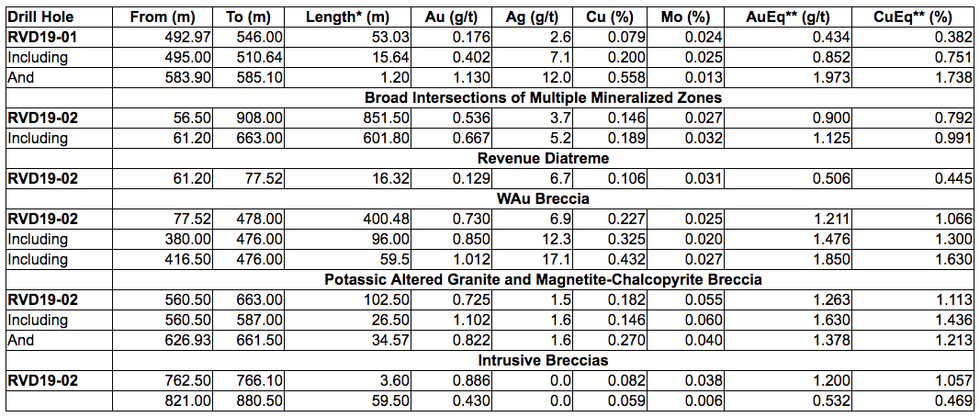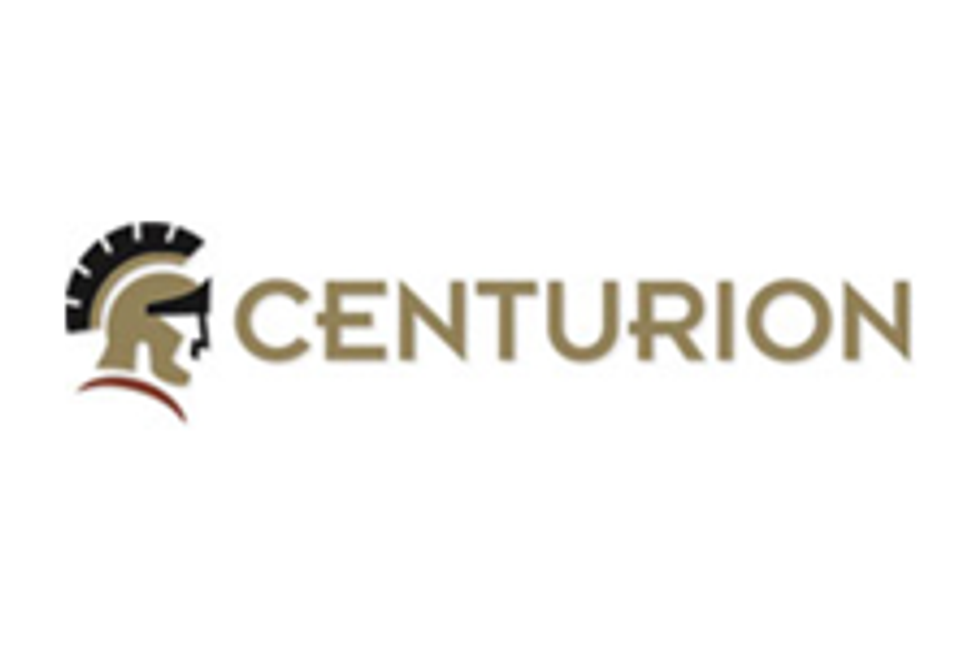Triumph Gold Intersects 400 metres of 1.2 g/t Gold Equivalent and 102 metres of 1.3 g/t Gold Equivalent in the First of Three Areas Tested for a Deep Porphyry

Triumph Gold Corp. announced results from the first two drill holes on their Freegold Mountain Property.
Triumph Gold Corp., (TSXV:TIG, OTCMKTS:TIGCF) (“Triumph Gold” or the “Company”) is pleased to announce positive results from the first two of seven planned drill holes testing for a buried porphyry on their 100% owned, 200 km2, road accessible Freegold Mountain Property in the Yukon Territory. Highlights include:
- A 400.48 metre intersection (RVD19-02, 77.52 – 478.00m) of epithermal style mineralization at the WAu Breccia with 1.21 grams per tonne (g/t) gold equivalent** (AuEq**), containing 0.73 g/t gold (Au) and 0.23% copper (Cu), more than doubling the previously known depth of mineralization.
- A 102.50 metre intersection (RVD19-02, 560.50 – 663.00) of gold-rich porphyry related mineralization (strongly potassic altered granite and chalcopyrite-magnetite breccia), with 1.26 g/t AuEq**, containing 0.73 g/t Au and 0.18% Cu.
- Based on positive results from drill holes RVD19-01 and RVD19-02, an additional drill hole has been added to the program to further test for high grade porphyry mineralization beneath the WAu Breccia.
Table 1: Highlighted Results from 2019 Drilling at the WAu Breccia
VP Exploration Dr. Tony Barresi (P.Geo.) Comments
“At the WAu Breccia, the first of three areas being drill tested in 2019 for buried porphyry mineralization, we have discovered a porphyry copper-gold system. The discovery intersection is long, high-grade, gold-rich and closer to surface than we had expected. We also more than doubled the known depth of the near surface, gold-rich, epithermal style WAu Breccia. Combined, the two mineralized zones form an impressively long and rich intersection, 601.80 metres averaging 1.1 g/t gold equivalent**, with 0.67 g/t of actual gold [Table 2]. Now, with the addition of a seventh drill hole to the program, we’ll be further delineating deep WAu this year.”
The 2019 exploration program on Triumph’s Freegold Mountain property was designed to test for a buried copper-gold porphyry system beneath the six kilometre long, Revenue-Nucleus soil and geophysical anomaly. With the addition of a third drill hole to the WAu Breccia area, the program now includes seven drill holes, totaling approximately 6,000 metres. The current results indicate success at the WAu Breccia, the first area tested. Triumph looks forward to receiving and releasing drill results from the other two target areas:
- The Blue Sky Zone, where Triumph discovered a gold-rich, high-grade porphyry in 2017/2018 (e.g. 316 metres of 1.1 g/t Au, 5.0 g/t Ag and 0.27% Cu in RVD18-19; see PR18-09 dated September 12, 2018); and
- Revenue West where two drill holes will test a geophysical target (Big Red; see PR#19-10 dated June 18, 2019).
Triumph to Drill Third Hole at the WAu Breccia
Based on exciting results from RVD19-01, and RVD19-02, the technical team at Triumph designed a third drill hole to test the buried porphyry system beneath the WAu Breccia. One of the most important alteration minerals in the buried porphyry is magnetite, which gives the affected rock a strong magnetic signature. Triumph’s pre-existing magnetic geophysical surveys are being used to vector towards more, and higher grade, porphyry related mineralization. A 3D inversion of 2018 ground magnetic data interprets a strong, coherent magnetic high close to where both RVD19-01 and RVD19-02 intersected strongly potassic altered rock (Figure 2). The newly added third drill hole will target the magnetic high, drilling into the center and most intense portion of it, while also testing a westerly portion of the WAu Breccia at depth, and hanging wall porphyry style mineralization closer to surface (Figures 2&4). In addition, Triumph plans to reprocess its magnetic data to build a “constrained”/more robust 3D model that will incorporate down-hole magnetic data collected from all of the drill holes in the vicinity of the ground magnetic survey; this will allow for even better recognition and resolution of deep magnetic bodies in preparation for a 2020 drill program.
Details of RVD19-01 and RVD19-02
Two drill holes were completed at the WAu Breccia totaling 1,664.21 metres (Figure 1, Figure 2, Table 3). The WAu breccia is a south dipping tabular body of polymetallic mineralization intersected by eight historical drill holes that tested to a maximum depth of 200m below surface. RVD19-01 was oriented northwards to test for a depth extension of the WAu breccia 250 metres beneath previous intersections. RVD19-02, was drilled southward along the same section and was designed to drill down the dip-plane of the WAu mineralized zone, to efficiently test continuity of the WAu mineralization to depth, while also using the breccia body as a vector towards an underlying porphyry system.
RVD19-01 intersected a 53 metre thick downdip extension of the WAu breccia (493 – 546m). Mineralization in this interval consists mainly of quartz-carbonate-sulfide veins versus breccia matrix. The best interval returned 0.40 g/t Au, 7.1 g/t Ag, 0.20% Cu, and 0.025% Mo over 15.64 metres (495.00 – 510.64m; Table 2). Below the breccia RVD19-01 intersected 29.78 metres (585.10 – 614.88m) of moderate to strong K-feldspar-biotite-magnetite altered and veined intrusion. The potassic alteration is interpreted to be part of a buried porphyry system that was also intersected in drill hole RVD19-02.
RVD19-02 was drilled down the dip plane of the WAu breccia, which near surface is demonstrated to have a thickness of approximately 50 metres, but below the depth of 200 metres has a poorly- or un- constrained thickness and geometry.
- RVD19-02 collared in the Revenue diatreme, which crosscuts and forms a shallow apron over the western portion of the WAu Breccia. The margin of the diatreme is mineralized, returning 0.11% Cu, 0.13 g/t Au 6.7 g/t Ag and 0.031% Mo over 16.32m (61.20-77.52m; Table 2).
- Below the diatreme contact (77.52m) to 476 metres depth RVD19-02 intersected the WAu Breccia, characterized by brecciated and argillic ± silica altered granite with Au-Ag-Cu-Mo (plus minor tungsten, zinc, and lead) mineralization within hydrothermal breccia matrix, and in surrounding wallrock and clasts. The breccia fill consists of pyrite, pyrrhotite, chalcopyrite, molybdenite, arsenopyrite, scheelite, sphalerite, galena, bismuthinite, and native gold (visible), combined with quartz and carbonate (calcite, dolomite, ankerite).
- Beneath the WAu Breccia, from 560.50 to 663.00 metres, RVD19-02 intersected strongly potassic altered granite (K-feldspar, biotite, magnetite) and chalcopyrite-molybdenite-magnetite breccia. This is interpreted to be part of a porphyry copper-gold system.
- Between 735 – 891 metres RVD19-02 intersected a high density of Au-Cu-Mo enriched dykes of intrusive breccia with disseminated sulfides that crosscut variably brecciated and altered granite.
- Mineralization begins in the diatreme at 56.50 metres and persists to a depth of 908.00 metres. Including low grade intervals, the 851.50 metre long mineralized intersection averages 0.90 g/t AuEq** (or 0.79% CuEq**), with 0.536 g/t Au, 3.7 g/t Ag, 0.146% Cu and 0.027% Mo (Table 2, Figure 2).
Table 2: Full Table of Significant Intersections from RVD19-01 and RVD19-02; WAu Breccia Area
TABLE 3: Drill Hole Locations and Orientations
Notes
* Reported assays are uncut weighted averages and represent drilled core lengths. The true width of reported mineralization is unknown.
** Gold equivalent [AuEq], and copper equivalent [CuEq] are used for illustrative purposes, to express the combined value of gold, silver, molybdenum and copper as a percentage of gold or copper. No allowances have been made for recovery losses that would occur in a mining scenario. AuEq and CuEq are calculated on the basis of US$2.50 per pound of copper, US$12.70 per pound of molybdenum, US$1,510 per troy ounce of gold and US$17.00 per troy ounce of silver.
AuEq = ($1510.00 X Au [g/t] / 31.10 + $17.00 X Ag [g/t] / 31.10 + $2.50 X Cu [%] /100 X 2204.63 + $12.70 X Mo [%] / 100 X 2204.63) / $1510.00 X 31.10
CuEq = ($1510.00 X Au [g/t] / 31.10 + $17.00 X Ag [g/t] / 31.10 + $2.50 X Cu [%] /100 X 2204.63 + $12.70 X Mo [%] / 100 X 2204.63) / $2.50 X 100 / 2204.63
Methods and Qualified Person
Drill core samples ranged between 1 and 2 metres length and were cut at Triumph’s core logging facility on the Freegold Mountain Property. The samples were analyzed by SGS Canada of Vancouver, British Columbia. They were prepared for analysis according to SGS method PRP89: each sample was crushed to 75% passing 2mm and a 250g split was pulverized to better than 85% passing 75 micron mesh. Gold was tested by fire assay with atomic absorption finish on a 30g nominal sample (method GE FAA313), and samples that tested over 10 g/t Au were retested using a 50g sample and a gravimetric technique. An additional 35 elements were tested by ICP-AES using a four-acid digestion (method GE ICP40B), over limit samples for copper were retested using the same technique but with ore grade four acid digestion and a higher range of detection (method GA AAS42S). Quality assurance and control (QAQC) is maintained at the lab through rigorous use of internal standards, blanks and duplicates. An additional QAQC program was administered by Triumph Gold: at minimum three quality control samples, consisting of blanks, certified reference standards and duplicates, are blindly inserted into each 75 sample batch. QAQC samples that return unacceptable values trigger investigations into the results and reanalyses of the samples that were tested in the batch with the failed QAQC sample.
The technical content of this news release has been reviewed and approved by Tony Barresi, Ph.D., P.Geo., VP Exploration for the company, and qualified person as defined by National Instrument 43-101.About Triumph Gold Corp.
Triumph Gold Corp. is a growth oriented Canadian-based precious metals exploration and development company. Triumph Gold Corp. is focused on creating value through the advancement of the district scale Freegold Mountain project in Yukon. For maps and more information, please visit our website www.triumphgoldcorp.com
On behalf of the Board of Directors
Signed “Paul Reynolds”
Paul Reynolds, President & CEO
| For further information please contact: John Anderson, Executive Chairman Triumph Gold Corp. (604) 218-7400 janderson@triumphgoldcorp.com | Nancy Massicotte IR Pro Communications Inc. (604)-507-3377 nancy@irprocommunications.com |
Neither the TSX Venture Exchange nor its Regulation Services Provider (as that term is defined in policies of the TSX Venture Exchange) accepts responsibility for the adequacy or accuracy of this release.
This news release contains forward-looking information, which involves known and unknown risks, uncertainties and other factors that may cause actual events to differ materially from current expectation. Important factors – including the availability of funds, the results of financing efforts, the completion of due diligence and the results of exploration activities – that could cause actual results to differ materially from the Company’s expectations are disclosed in the Company’s documents filed from time to time on SEDAR (see www.sedar.com). Readers are cautioned not to place undue reliance on these forward-looking statements, which speak only as of the date of this press release. The company disclaims any intention or obligation, except to the extent required by law, to update or revise any forward-looking statements, whether as a result of new information, future events or otherwise.
Five images accompanying this announcement are available at:
Figure 1 Plan Geology Map Showing Locations of RVD19-01 and RVD19-02
Figure 2 Cross Section Showing Down Hole Au and Cu Values
Figure 4 Schematic Model of Blue Sky – WAu – Diatreme Porphyry System
Figure 5 Core Photos of WAu Breccia and Magnetite-Chalcopyrite Breccia








